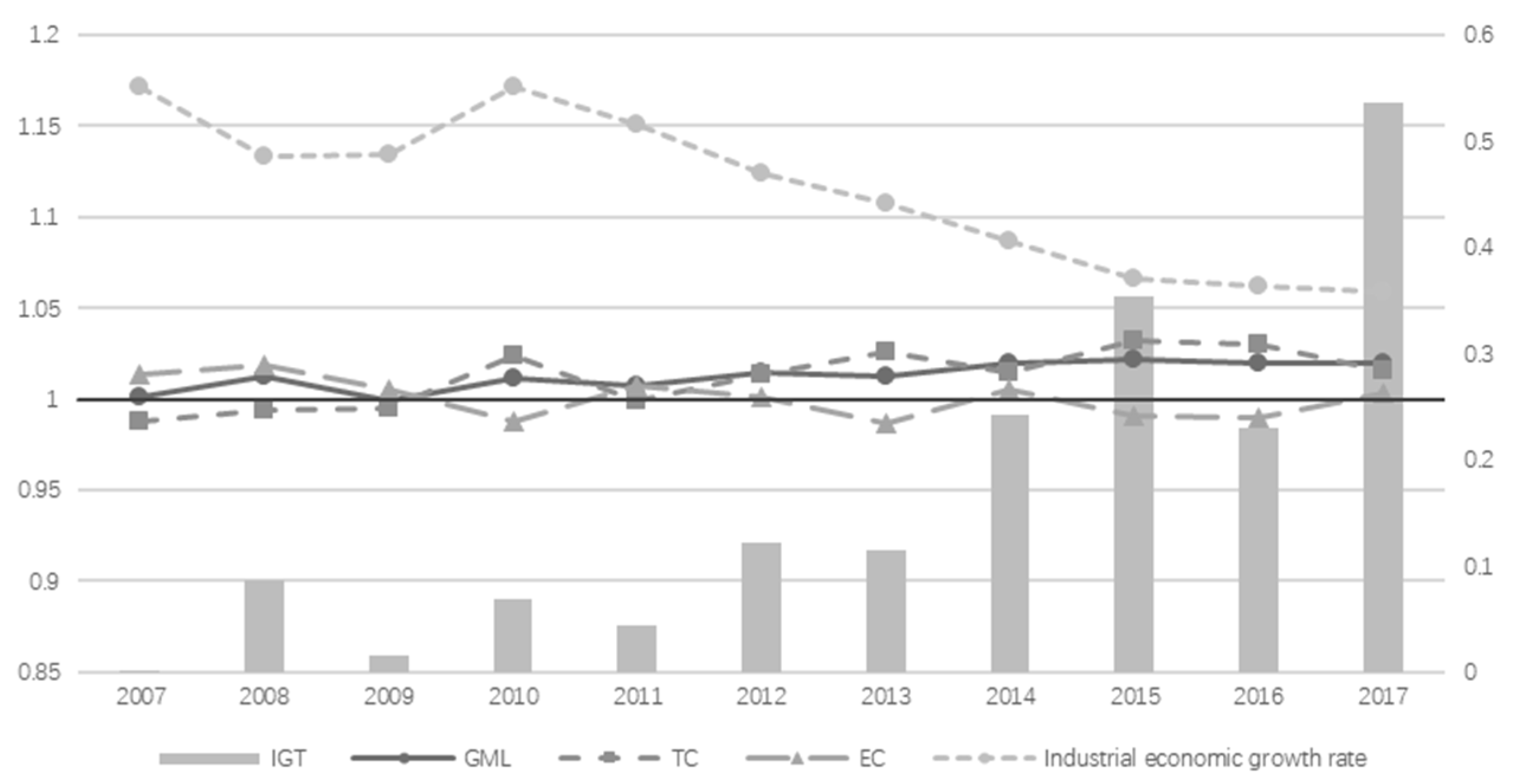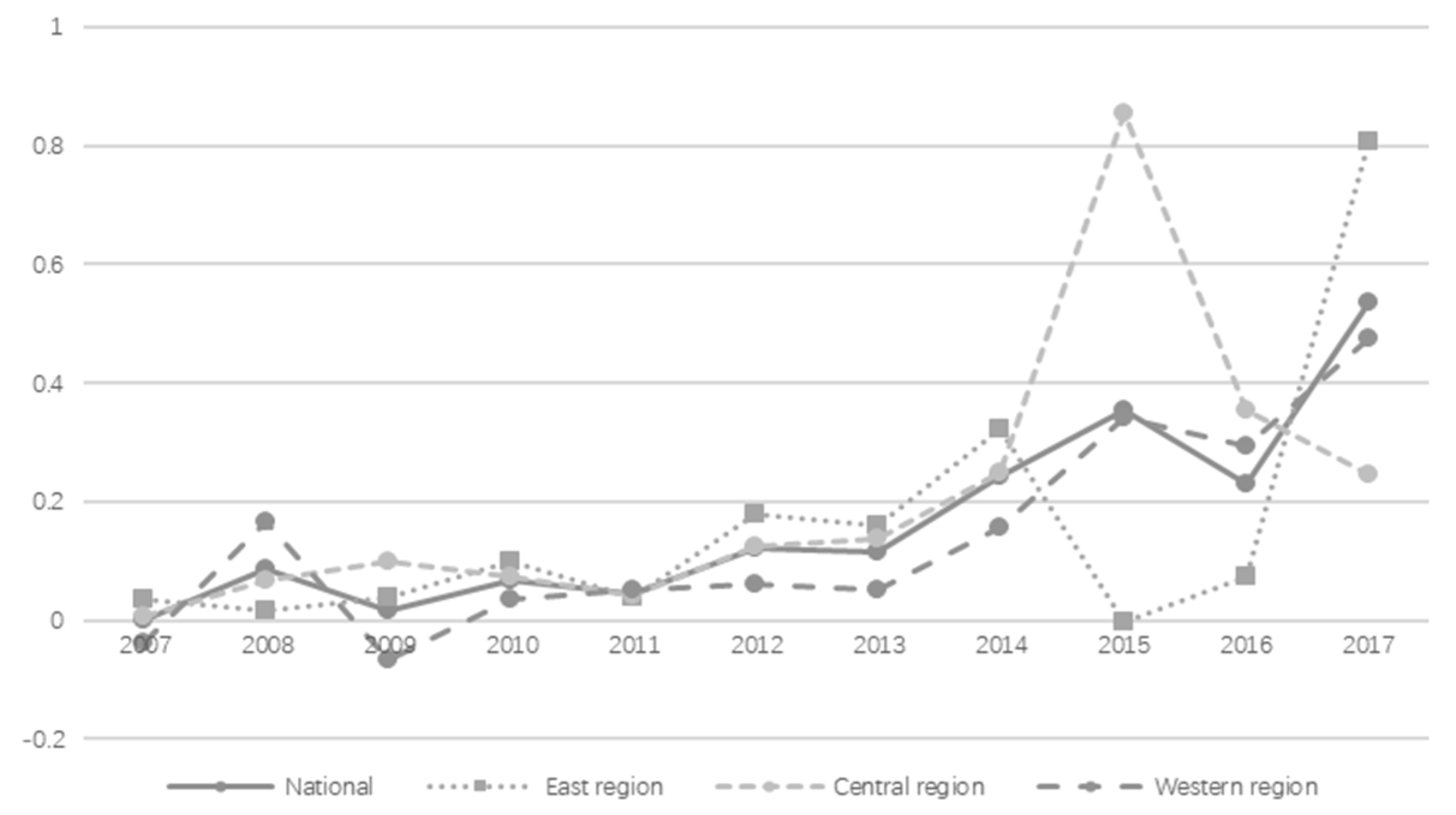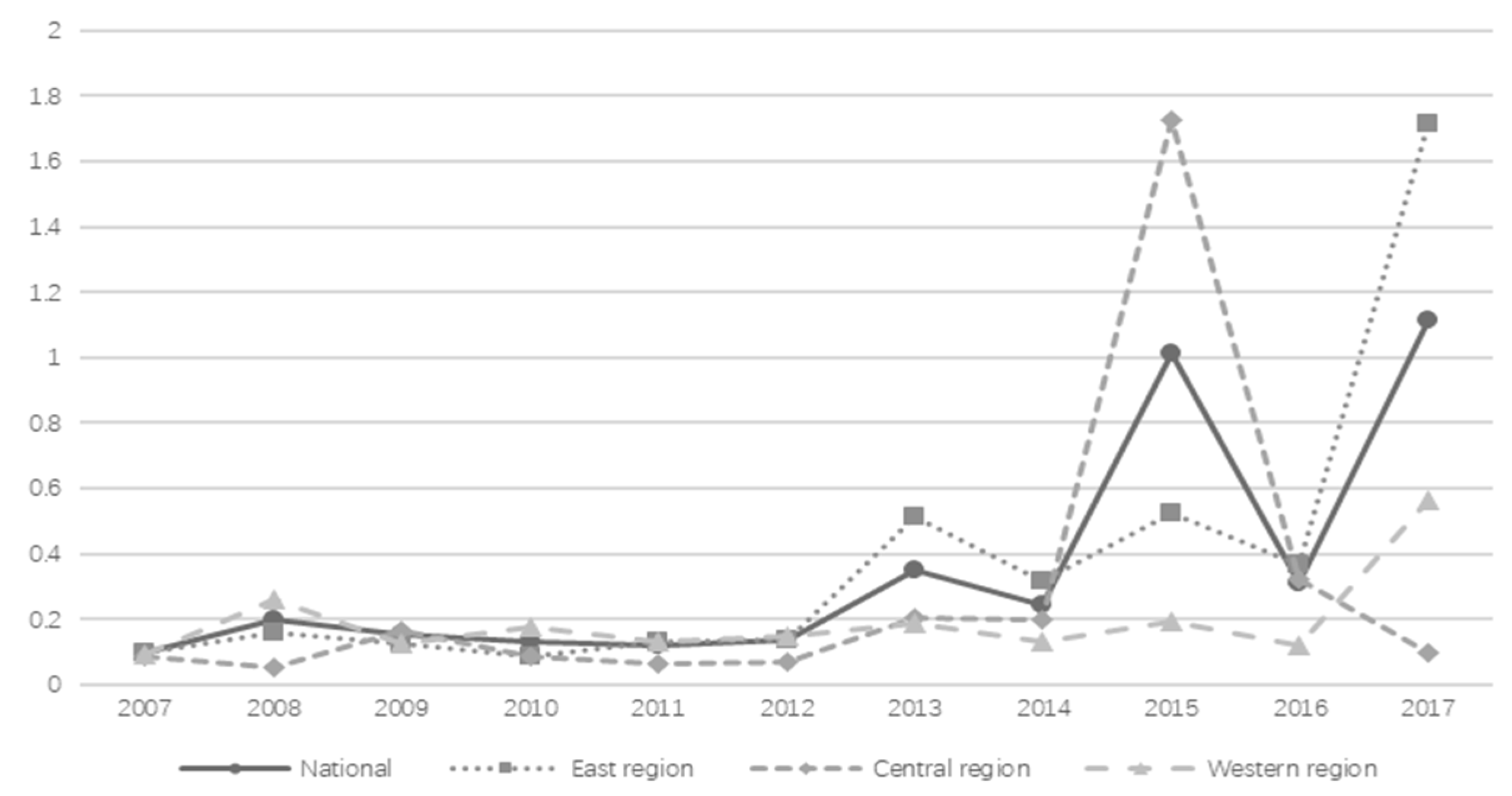Evaluation of Industrial Green Transformation in the Process of Urbanization: Regional Difference Analysis in China
Abstract
:1. Introduction
2. Materials and Methods
2.1. Directional Distance Function and Global Malmquist–Luenberger Index Methods
2.2. Spatial–Temporal Evolution and Regional Difference Analysis Method
2.2.1. Kernel Density Estimation
2.2.2. σ Convergence
2.2.3. Spatial Correlation
2.3. Variable Selection and Data Sources
- (1)
- Input indicator: We selected capital, labor and energy as the input factors. First, the capital investment takes the industrial capital stock as a representative index. We estimated the index using the perpetual inventory method, and the expression is [44]. Taking 2005 as the base year, the initial industrial capital stock is represented by dividing the industrial fixed asset investment in the current year by 10%. The industrial fixed asset investment is the sum of fixed asset investment in mining, manufacturing, and the production and supply of electricity, gas and water. We used 6% of the non-agricultural depreciation rate as a fixed depreciation rate [45]. Taking into account the factors of price changes, the investment is represented by the fixed asset investment converted at the constant price of the base year of the fixed asset investment index. Second, the labor input indicator is measured by the total number of employed persons in the industrial fields of each province. Third, the energy input is measured by the total energy consumption of each province. As there are no direct data, the data statistics ranges on industrial capital, labor and energy in this paper are all based on the industry categories covered in China Industry Statistical Yearbook, including mining, manufacturing, production, and the supply of electricity, gas and water.
- (2)
- Output indicators: First, the expected output is measured by the industrial added value. Taking the previous year as the base period, the industrial added value is converted at a constant price with the GDP index of the secondary industry. Second, the undesired output is measured by the environmental pollution index, which is constructed by the entropy method. This index is composed of three secondary indicators: total industrial wastewater discharge, total industrial waste gas discharge, and general industrial solid waste generation. The larger the indicator value is, the more polluting wastes are produced.
- (3)
- Urbanization indicator: The measurement indicators of urbanization are selected from the two aspects of land and population. The urban area is used to represent the urbanization of land, and the urban population is used to represent the degree of urbanization of the population.
3. Results
3.1. Analysis of the IGT Index in the Process of Urbanization
3.2. Analysis of Spatial–Temporal Evolution and Regional Differences
3.2.1. Kernel Density Estimation Analysis
3.2.2. σ Convergence Analysis
3.2.3. Spatial Correlation Analysis of IGT
4. Conclusions
- (1)
- Under the background of the urbanization process, China’s industrial economy’s green transformation performance has been continuously improved. The changes in the IGT are staged, and show a leaping upward trend. In terms of space, the growth effect in the central region is the best, followed by that in the eastern region. The western region lags behind.
- (2)
- The kernel density curve and σ coefficient show that although the green transformation level of the eastern industry is continuously improving, the internal gap is gradually widening. The west has been in a state of development with a large gap for a long time. Although the level of transformation in the central region is relatively balanced, the improvement effect is relatively low.
- (3)
- The local Moran’s I index shows more negative spatial correlation, with significant differences in the neighboring provinces. The high values are mostly concentrated in the eastern region, and the differences within the region are obvious. Low values are mostly concentrated in the central and western regions, which are more balanced than those in the east.
Author Contributions
Funding
Institutional Review Board Statement
Informed Consent Statement
Data Availability Statement
Conflicts of Interest
References
- Yang, Z.B.; Shao, S.; Yang, L.L.; Miao, Z. Improvement pathway of energy consumption structure in China’s industrial sector: From the perspective of directed technical change. Energy Econ. 2018, 72, 166–176. [Google Scholar] [CrossRef]
- Shao, S.A.; Luan, R.R.; Yang, Z.B.; Li, C.Y. Does directed technological change get greener: Empirical evidence from Shanghai’s industrial green development transformation. Ecol. Indic. 2016, 69, 758–770. [Google Scholar] [CrossRef]
- Institute of Industrial Economics CASS; Li, P. A study on the green transformation of Chinese industry. China Ind. Econ. 2011, 4, 5–14. [Google Scholar]
- Mao, W.X.; Wang, W.P.; Sun, H.F. Driving patterns of industrial green transformation: A multiple regions case learning from China. Sci. Total Environ. 2019, 697, 134134. [Google Scholar] [CrossRef] [PubMed]
- Pegels, A.; Lutkenhorst, W. Is Germany’s energy transition a case of successful green industrial policy? Contrasting wind and solar PV. Energy Policy 2014, 74, 522–534. [Google Scholar] [CrossRef] [Green Version]
- Xie, W.C.; Yan, T.H.; Xia, S.M.; Chen, F.Z. Innovation or introduction? The impact of technological progress sources on industrial green transformation of resource-based cities in China. Front. Energy Res. 2020, 8, 598141. [Google Scholar] [CrossRef]
- Wu, H.T.; Hao, Y.; Ren, S.Y. How do environmental regulation and environmental decentralization affect green total factor energy efficiency: Evidence from China. Energy Econ. 2020, 91, 104880. [Google Scholar] [CrossRef]
- Li, H.J.; Li, B. The threshold effect of environmental regulation on the green transition of the industrial economy in China. Econ. Res.-Ekon. Istraživanja 2019, 32, 3128–3143. [Google Scholar] [CrossRef] [Green Version]
- Ouyang, X.L.; Li, Q.; Du, K.R. How does environmental regulation promote technological innovations in the industrial sector? Evidence from Chinese provincial panel data. Energy Policy 2020, 139, 111310. [Google Scholar] [CrossRef]
- Han, D.R.; Li, T.C.; Feng, S.S.; Shi, Z.Y. Does renewable energy consumption successfully promote the green transformation of China’s industry? Energies 2020, 13, 229. [Google Scholar] [CrossRef] [Green Version]
- Shao, S.; Yang, Z.B.; Yang, L.; Ma, S. Can China’s energy intensity constraint policy promote total factor energy efficiency? Evidence from the industrial sector. Energy J. 2019, 40, 101–127. [Google Scholar] [CrossRef]
- Lv, X.F.; Lu, X.L.; Fu, G.; Wu, C.Y. A spatial-temporal approach to evaluate the dynamic evolution of green growth in China. Sustainability 2018, 10, 2341. [Google Scholar] [CrossRef] [Green Version]
- Song, L.; Zhou, X.L. Does the green industry policy reduce industrial pollution emissions?—Evidence from China’s national eco-industrial park. Sustainability 2021, 13, 6343. [Google Scholar] [CrossRef]
- Li, T.H.; Ma, J.H.; Mo, B. Does environmental policy affect green total factor productivity? Quasi-natural experiment based on China’s air pollution control and prevention action plan. Int. J. Environ. Res. Public Health 2021, 18, 8216. [Google Scholar] [CrossRef] [PubMed]
- Cui, H.R.; Lui, Z.L. Spatial-temporal pattern and influencing factors of the urban green development efficiency in Jing-Jin-Ji region of China. Pol. J. Environ. Stud. 2021, 30, 1079–1093. [Google Scholar] [CrossRef]
- Guo, K.L.; Li, S.X.; Wang, Z.Q.; Shi, J.R.; Bai, J.; Cheng, J.H. Impact of regional green development strategy on environmental total factor productivity: Evidence from the Yangtze River Economic Belt, China. Int. J. Environ. Res. Public Health 2021, 18, 2496. [Google Scholar] [CrossRef]
- Liu, T.; Li, Y. Green development of China’s Pan-Pearl River Delta mega-urban agglomeration. Sci. Rep. 2021, 11, 15717. [Google Scholar] [CrossRef] [PubMed]
- Zhou, L.; Zhou, C.H.; Che, L.; Wang, B. Spatio-temporal evolution and influencing factors of urban green development efficiency in China. J. Geogr. Sci. 2020, 30, 724–742. [Google Scholar] [CrossRef]
- Meng, G.F.; Guo, Z.; Li, J.L. The dynamic linkage among urbanisation, industrialisation and carbon emissions in China: Insights from spatiotemporal effect. Sci. Total Environ. 2021, 760, 144042. [Google Scholar] [CrossRef] [PubMed]
- Guo, J.; Xu, Y.Z.; Pu, Z.N. Urbanization and its effects on industrial pollutant emissions: An empirical study of a Chinese case with the spatial panel model. Sustainability 2016, 8, 812. [Google Scholar] [CrossRef] [Green Version]
- Sarwar, S.; Alsaggaf, M.I. Role of urbanization and urban income in carbon emissions: Regional analysis of China. Appl. Ecol. Env. Res. 2019, 17, 10303–10311. [Google Scholar] [CrossRef]
- Sun, W.; Huang, C.C. How does urbanization affect carbon emission efficiency? Evidence from China. J. Clean. Prod. 2020, 272, 122828. [Google Scholar] [CrossRef]
- Liu, X.H. Impact of urbanization on energy consumption and haze in China—A review. Energy Source Part A Recovery Util. Environ. Eff. 2019, 4, 1648601. [Google Scholar] [CrossRef]
- Zhang, D.; Wang, Z.Q.; Li, S.C.; Zhang, H.W. Impact of land urbanization on carbon emissions in urban agglomerations of the middle reaches of the Yangtze River. Int. J. Environ. Res. Public Health 2021, 18, 1403. [Google Scholar] [CrossRef] [PubMed]
- Zhang, T.F.; Song, Y.; Yang, J. Relationships between urbanization and CO2 emissions in China: An empirical analysis of population migration. PLoS ONE. 2021, 16, e0256335. [Google Scholar] [CrossRef] [PubMed]
- Zhang, G.L.; Zhang, N.; Liao, W.M. How do population and land urbanization affect CO2 emissions under gravity center change? A spatial econometric analysis. J. Clean. Prod. 2018, 202, 510–523. [Google Scholar] [CrossRef]
- Wang, Y.N.; Luo, X.Y.; Chen, W.; Zhao, M.J.; Wang, B.W. Exploring the spatial effect of urbanization on multi-sectoral CO2 emissions in China. Atmos. Pollut. Res. 2019, 10, 1610–1620. [Google Scholar] [CrossRef]
- Xu, S.C.; Miao, Y.M.; Gao, C.; Long, R.Y.; Chen, H.; Zhao, B.; Wang, S.X. Regional differences in impacts of economic growth and urbanization on air pollutants in China based on provincial panel estimation. J. Clean. Prod. 2019, 208, 340–352. [Google Scholar] [CrossRef]
- Li, Q.Y.; Zeng, F.E.; Liu, S.H.; Yang, M.A.; Xu, F. The effects of China’s sustainable development policy for resource-based cities on local industrial transformation. Resour. Policy 2020, 71, 101940. [Google Scholar] [CrossRef]
- Tang, M.G.; Li, Z.; Hu, F.X.; Wu, B.J. How does land urbanization promote urban eco-efficiency? The mediating effect of industrial structure advancement. J. Clean. Prod. 2020, 272, 122798. [Google Scholar] [CrossRef]
- Lin, S.F.; Sun, J.; Marinova, D.; Zhao, D.T. Effects of population and land urbanization on China’s environmental impact: Empirical analysis based on the extended STIRPAT model. Sustainability 2017, 9, 825. [Google Scholar] [CrossRef] [Green Version]
- Hou, J.; Teo, T.; Zhou, F.L.; Lim, M.K.; Chen, H. Does industrial green transformation successfully facilitate a decrease in carbon intensity in China? An environmental regulation perspective. J. Clean. Prod. 2018, 184, 1060–1071. [Google Scholar] [CrossRef]
- Kuai, P.; Li, W.; Cheng, R.H.; Cheng, G. An application of system dynamics for evaluating planning alternatives to guide a green industrial transformation in a resource-based city. J. Clean. Prod. 2015, 104, 403–412. [Google Scholar] [CrossRef]
- Lai, A.L.; Yang, Z.H.; Cui, L.B. Market segmentation impact on industrial transformation: Evidence for environmental protection in China. J. Clean. Prod. 2021, 297, 126607. [Google Scholar] [CrossRef]
- Gu, B.B.; Chen, F.; Zhang, K. The policy effect of green finance in promoting industrial transformation and upgrading efficiency in China: Analysis from the perspective of government regulation and public environmental demands. Environ. Sci. Pollut. Res. 2021, 28, 47474–47491. [Google Scholar] [CrossRef] [PubMed]
- Feng, M.; Yan, Y.F.; Li, X.H. Measuring the efficiency of industrial green transformation in China. J. Sci. Ind. Res. 2019, 78, 495–498. [Google Scholar]
- Fu, J.P.; Xiao, G.R.; Guo, L.L.; Wu, C.Y. Measuring the dynamic efficiency of regional industrial green transformation in China. Sustainability 2018, 10, 628. [Google Scholar] [CrossRef] [Green Version]
- Shi, X.Q.; Wang, X.; Chen, P. A network-based approach for analyzing industrial green transformation: A case study of Beijing, China. J. Clean. Prod. 2021, 317, 128281. [Google Scholar] [CrossRef]
- Gatto, F.; Daniotti, S.; Re, I. Driving Green Investments by Measuring Innovation Impacts. Multi-Criteria Decision Analysis for Regional Bioeconomy Growth. Sustainability 2021, 13, 1709. [Google Scholar] [CrossRef]
- Chung, Y.H.; Färe, R.; Grosskopf, S. Productivity and undesirable outputs: A directional distance function approach. J. Environ. Manag. 1997, 51, 229–240. [Google Scholar] [CrossRef] [Green Version]
- Oh, D.H. A global Malmquist-Luenberger productivity index. J. Product. Anal. 2010, 34, 183–197. [Google Scholar] [CrossRef]
- Cheng, G.; Zervopooulos, P.D. Estimating the technical efficiency of health care systems: A cross-country comparison using the directional distance function. Eur. J. Oper. Res. 2014, 238, 899–910. [Google Scholar] [CrossRef] [Green Version]
- Bin, L.I.; Peng, X.; Ouyang, M.K. Environmental regulation, green total factor productivity and the transformation of China’s industrial development mode—Analysis based on data of China’s 36 industries. China Ind. Econ. 2013, 4, 56–68. [Google Scholar]
- Zhang, J.; Wu, G.Y.; Zhang, J.P. The estimation of China’ s provincial capital stock: 1952–2000. Econ. Res. J. 2004, 10, 35–44. [Google Scholar]
- Young, A. Gold into base metals: Productivity growth in the People’s Republic of China during the reform period. J. Polit. Econ. 2000, 111, 1220–1261. [Google Scholar] [CrossRef] [Green Version]
- Li, J.M.; Yang, Y.; Fan, J.; Jin, F.J.; Zhang, W.Z.; Liu, S.H.; Fu, B.J. Comparative research on regional differences in urbanization and spatial evolution of urban systems between China and India. J. Geogr. Sci. 2018, 28, 1860–1876. [Google Scholar]
- Wang, X.X. Empirical Analysis of the Rationality of China’s Urbanization Level on National and Regional Levels. J. Urban Plan Dev. 2017, 143, 04016035. [Google Scholar] [CrossRef]
- Zhong, L.N.; Li, X.N.; Law, R.; Sun, S. Developing Sustainable Urbanization Index: Case of China. Sustainability 2020, 12, 4585. [Google Scholar] [CrossRef]
- Xu, S.C.; He, Z.X.; Long, R.Y.; Shen, W.X.; Ji, S.B.; Chen, Q.B. Impacts of economic growth and urbanization on CO2 emissions: Regional differences in China based on panel estimation. Reg. Environ. Change 2016, 16, 777–787. [Google Scholar] [CrossRef]
- D’Amico, G.; Arbolino, R.; Shi, L.; Yigitcanlar, T.; Ioppolo, G. Digital technologies for urban metabolism efficiency: Lessons from urban agenda partnership on circular economy. Sustainability 2021, 13, 6043. [Google Scholar] [CrossRef]
- Wei, C.; Lin, Q.; Yu, L.; Zhang, H.; Ye, S.; Zhang, D. Research on sustainable land use based on production–living–ecological function: A case study of Hubei province, China. Sustainability 2021, 13, 996. [Google Scholar] [CrossRef]
- Acerbi, F.; Sassanelli, C.; Terzi, S.; Taisch, M. A systematic literature review on data and information required for circular manufacturing strategies adoption. Sustainability 2021, 13, 2047. [Google Scholar] [CrossRef]
- D’Adamo, I.; Gastaldi, M.; Morone, P.; Rosa, P.; Sassanelli, C.; Settembre-Blundo, D.; Shen, Y. Bioeconomy of Sustainability: Drivers, Opportunities and Policy Implications. Sustainability 2022, 14, 200. [Google Scholar] [CrossRef]





| Excluding Urbanization | Including Urbanization | Excluding Urbanization | Including Urbanization | ||
|---|---|---|---|---|---|
| 2007 | 1.0216 | 1.0006 | 2013 | 1.0241 | 1.0124 |
| 2008 | 1.0209 | 1.0122 | 2014 | 1.0253 | 1.0201 |
| 2009 | 1.0210 | 0.9992 | 2015 | 1.0230 | 1.0218 |
| 2010 | 1.0288 | 1.0113 | 2016 | 1.0206 | 1.0195 |
| 2011 | 1.0263 | 1.0068 | 2017 | 1.0221 | 1.0194 |
| 2012 | 1.0271 | 1.0140 | / | / | / |
Publisher’s Note: MDPI stays neutral with regard to jurisdictional claims in published maps and institutional affiliations. |
© 2022 by the authors. Licensee MDPI, Basel, Switzerland. This article is an open access article distributed under the terms and conditions of the Creative Commons Attribution (CC BY) license (https://creativecommons.org/licenses/by/4.0/).
Share and Cite
Yue, J.-P.; Zhang, F.-Q. Evaluation of Industrial Green Transformation in the Process of Urbanization: Regional Difference Analysis in China. Sustainability 2022, 14, 4280. https://doi.org/10.3390/su14074280
Yue J-P, Zhang F-Q. Evaluation of Industrial Green Transformation in the Process of Urbanization: Regional Difference Analysis in China. Sustainability. 2022; 14(7):4280. https://doi.org/10.3390/su14074280
Chicago/Turabian StyleYue, Jia-Pei, and Fu-Qin Zhang. 2022. "Evaluation of Industrial Green Transformation in the Process of Urbanization: Regional Difference Analysis in China" Sustainability 14, no. 7: 4280. https://doi.org/10.3390/su14074280
APA StyleYue, J.-P., & Zhang, F.-Q. (2022). Evaluation of Industrial Green Transformation in the Process of Urbanization: Regional Difference Analysis in China. Sustainability, 14(7), 4280. https://doi.org/10.3390/su14074280






